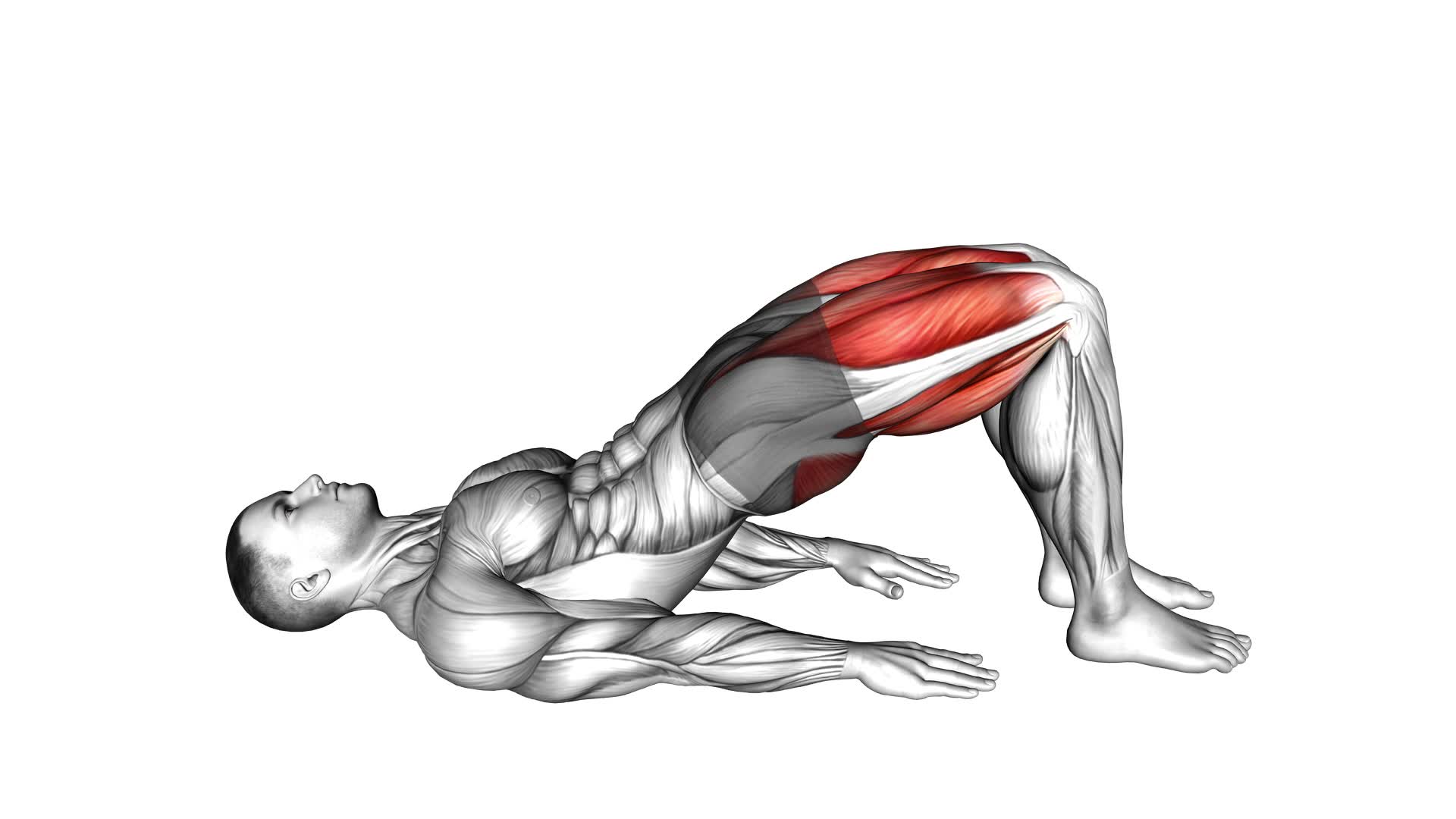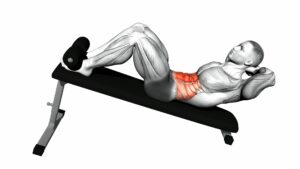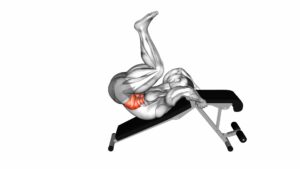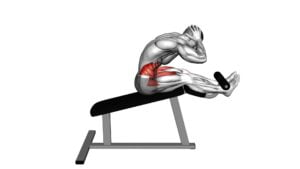Rear Decline Bridge – Video Exercise Guide & Tips

Are you looking for a challenging exercise that targets your glutes and hamstrings? Look no further than the Rear Decline Bridge!
Watch This Exercise Video
This video exercise guide and tips will show you the proper form and technique to maximize your results.
Avoid common mistakes and discover variations to push yourself further.
Get ready to incorporate the Rear Decline Bridge into your workout routine and take your fitness to the next level.
Let's get started!
Key Takeaways
- The rear decline bridge is highly effective for strengthening glutes and improving core stability.
- It engages multiple muscle groups, including glutes, hamstrings, and lower back, for a well-rounded workout.
- Proper form and technique are crucial to maximize the benefits and avoid injury.
- Increasing intensity and incorporating variations can help challenge the muscles and progress over time.
Benefits of the Rear Decline Bridge
Get strong glutes and a stable core with the Rear Decline Bridge. This exercise is highly effective for strengthening glutes and improving core stability. By targeting the muscles in your glutes, the Rear Decline Bridge helps to shape and tone your backside, giving you a firm and sculpted look. Additionally, it engages your core muscles, including your abdominals and lower back, to provide stability and support during movement.
When performing the Rear Decline Bridge, your glutes become the primary muscle group being worked. As you lift your hips off the ground, you activate these muscles, forcing them to contract and become stronger over time. This not only enhances the appearance of your glutes but also improves their functionality in everyday activities such as walking, running, and lifting.
Furthermore, the Rear Decline Bridge also targets your core muscles, which play a crucial role in maintaining proper posture and stability. As you hold the bridge position, your core muscles engage to keep your body aligned and balanced. This helps to improve overall core strength, which can reduce the risk of injuries and enhance athletic performance.
To perform the Rear Decline Bridge with proper form and technique, continue reading the next section.
Proper Form and Technique for the Exercise
To perform the Rear Decline Bridge with proper form and technique, you should focus on maintaining a strong and stable position throughout the exercise. This is crucial to ensure that you engage the correct muscles and avoid injury. One of the common misconceptions about this exercise is that it primarily targets the glutes. While the glutes are indeed activated, the Rear Decline Bridge also engages the hamstrings, lower back, and core muscles. It's important to keep your body in a straight line from your head to your heels, avoiding any sagging or arching in the lower back. This will help you maximize the effectiveness of the exercise and prevent strain on your back.
If you're a beginner or find the Rear Decline Bridge too challenging, there are modifications you can make to gradually build up your strength. You can start by performing the exercise with your feet on the ground instead of on an elevated surface. This will reduce the difficulty and allow you to focus on proper form. As you become more comfortable and stronger, you can gradually progress to an elevated surface. Additionally, you can also perform the exercise with bent knees instead of straight legs to decrease the intensity.
Common Mistakes to Avoid While Performing the Rear Decline Bridge
Avoiding common mistakes is crucial when performing the Rear Decline Bridge exercise. To ensure that you're getting the most out of this exercise and reducing the risk of injury, here are some common mistakes to avoid and tips for proper technique:
- Arching your back: One of the most common mistakes is arching your back instead of keeping it straight. This not only reduces the effectiveness of the exercise but also puts unnecessary strain on your lower back. Focus on engaging your core and maintaining a neutral spine throughout the movement.
- Raising your hips too high: Another mistake is raising your hips too high, which can lead to hyperextension of the lower back. Instead, aim to keep your body in a straight line from your head to your heels. This will help target the glutes and hamstrings effectively.
- Neglecting proper breathing: Breathing is often overlooked during exercises, but it plays a crucial role in maintaining stability and control. Remember to exhale as you lift your hips and inhale as you lower them back down.
- Rushing the movement: It's important to perform the Rear Decline Bridge exercise slowly and with control. Avoid rushing through the movement, as this can compromise your form and increase the risk of injury. Focus on maintaining proper technique throughout the entire range of motion.
Variations and Progressions to Challenge Yourself
To further challenge yourself and continue progressing in the Rear Decline Bridge exercise, you can explore different variations and progressions. These advanced modifications won't only add excitement to your workout routine but also increase muscle activation for a more intense and effective workout.
One variation you can try is the Single-Leg Rear Decline Bridge. Instead of having both feet on the ground, lift one leg off the floor and extend it straight out in front of you. This will require more stability and strength, as you'll be relying on just one leg to support your body weight. Be sure to alternate legs to work both sides evenly.
Another progression is the Weighted Rear Decline Bridge. By adding a weight plate or dumbbell on your hips, you'll increase the resistance and challenge your glutes and hamstrings even more. Start with a lighter weight and gradually increase as you get stronger.
Lastly, you can try the Swiss Ball Rear Decline Bridge. Place your feet on a Swiss ball instead of a bench or step. This unstable surface will engage your core muscles even further as you work to maintain your balance throughout the exercise.
Remember to always maintain proper form and listen to your body. These variations and progressions should only be attempted once you have mastered the basic Rear Decline Bridge.
Tips for Incorporating the Rear Decline Bridge Into Your Workout Routine
To incorporate the Rear Decline Bridge into your workout routine, start by focusing on proper form and gradually increasing the difficulty level. Here are some tips to help you get the most out of this exercise:
- Modify the rear decline bridge: If you're new to this exercise or have any limitations, you can make some modifications to suit your needs. One option is to perform the exercise with your feet on the ground instead of on an elevated surface. This will decrease the intensity and allow you to build strength gradually. Another modification is to use a stability ball instead of an elevated surface, which can provide additional support and stability.
- Engage your core: The rear decline bridge primarily targets your glutes and hamstrings, but it's important to also engage your core muscles throughout the exercise. This will help stabilize your body and protect your lower back. Imagine pulling your belly button towards your spine and maintain that engagement throughout the movement.
- Increase the intensity: Once you have mastered the basic form of the rear decline bridge, you can start increasing the intensity. One way to do this is by adding resistance. You can place a weight plate or a barbell on your hips to make the exercise more challenging. Another option is to perform single-leg variations, where you lift one leg off the ground while maintaining the bridge position. This will increase the demand on your glutes and hamstrings.
- Progress gradually: As with any exercise, it's important to progress gradually to avoid injuries. Start with a lower difficulty level and gradually increase the intensity over time. Listen to your body and only progress when you feel ready. Remember, it's better to perform the exercise with proper form at a lower intensity than to rush into a more challenging variation and risk injury.
Frequently Asked Questions
How Many Sets and Reps Should I Do When Performing the Rear Decline Bridge?
When performing the rear decline bridge, it's important to consider the number of sets and reps you should do to maximize your workout. Sets and reps will vary depending on your fitness level and goals.
Start with 2-3 sets of 10-12 reps and gradually increase as you progress. As you become more comfortable, you can also try different variations and progressions to challenge yourself and target different muscles.
Remember to listen to your body and adjust accordingly.
Can the Rear Decline Bridge Help Improve Posture?
Improving your posture is essential for overall health and performance. The rear decline bridge is a great exercise to help you achieve better posture. By targeting your posterior chain, it strengthens the muscles that support your spine and shoulders.
This exercise also benefits athletes by improving stability and reducing the risk of injury. So, if you want to stand tall and perform at your best, incorporating the rear decline bridge into your routine is a smart move.
Is It Necessary to Use a Bench When Performing the Rear Decline Bridge, or Can It Be Done on the Floor?
When it comes to the rear decline bridge, you might be wondering if you need a bench or if it can be done on the floor.
Well, let me tell you, it's not necessary to use a bench. You can definitely perform this exercise on the floor.
In fact, there are benefits to doing it on the floor, like increased stability and engagement of the core muscles.
Are There Any Modifications or Alternatives for Individuals Who May Have Lower Back Pain?
If you're dealing with lower back pain, don't worry, there are modifications and variations for you.
You don't necessarily need to use a bench for the rear decline bridge – it can be done on the floor too.
To ease the strain on your lower back, you can try performing the exercise with your knees bent or on an incline instead.
These modifications will help protect your back while still working your glutes effectively.
Can the Rear Decline Bridge Be Beneficial for Athletes in Specific Sports, Such as Runners or Cyclists?
The rear decline bridge can definitely benefit athletes in specific sports, like runners or cyclists. It can improve the strength and stability of your glutes, hamstrings, and core, which are crucial for sprinting and endurance activities.
By incorporating this exercise into your routine, you'll notice an increase in power, speed, and overall performance.
Conclusion
Incorporating the rear decline bridge into your workout routine can bring a range of benefits. This exercise is particularly effective at strengthening your glutes, hamstrings, and lower back. To maximize the effectiveness of this exercise, it is important to maintain proper form and technique. Avoid common mistakes such as arching your back or using momentum to lift your hips.
To challenge yourself and continue progressing, try variations and progressions of the rear decline bridge. There are many ways to increase the difficulty of this exercise, such as adding resistance bands or using a stability ball. These variations can help you further strengthen your muscles and improve your stability.
Start incorporating the rear decline bridge into your workout routine today and watch your strength and stability soar. This exercise can be a valuable addition to your fitness regimen and can help you achieve your goals. Remember to always listen to your body and adjust the exercise as needed to avoid any discomfort or injury.

Author
Years ago, the spark of my life’s passion ignited in my mind the moment I stepped into the local gym for the first time. The inaugural bead of perspiration, the initial endeavor, the very first surge of endorphins, and a sense of pride that washed over me post-workout marked the beginning of my deep-seated interest in strength sports, fitness, and sports nutrition. This very curiosity blossomed rapidly into a profound fascination, propelling me to earn a Master’s degree in Physical Education from the Academy of Physical Education in Krakow, followed by a Sports Manager diploma from the Jagiellonian University. My journey of growth led me to gain more specialized qualifications, such as being a certified personal trainer with a focus on sports dietetics, a lifeguard, and an instructor for wellness and corrective gymnastics. Theoretical knowledge paired seamlessly with practical experience, reinforcing my belief that the transformation of individuals under my guidance was also a reflection of my personal growth. This belief holds true even today. Each day, I strive to push the boundaries and explore new realms. These realms gently elevate me to greater heights. The unique combination of passion for my field and the continuous quest for growth fuels my drive to break new ground.







